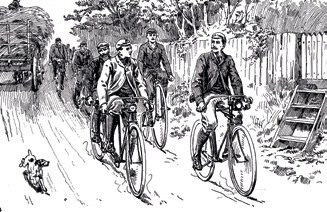The best way to keep in touch with Hand Picked Hotels is to sign up to our news, offers and events below. Please do read our Privacy Policy for more information on how we use your data and you can of course opt out at any time.
Pedal Power
The UK is rapidly becoming a nation of cyclists, but beyond its health and environmental merits, cycling is also emerging as a predominant competitive sport. Hand Picked Magazine takes a whistle-stop tour of its origins from a recreational pursuit to a multi-million-pound industry.
Perhaps unsurprisingly, during the Covid pandemic, cycling increased by 200% in the UK following the national lockdown, but the UK’s average mileage per year has been steadily growing since 1993. Data from Sport England reported that the number of people participating in cycling in England between 2016 and 2021 rose by a staggering 28%, and this trend shows little sign of slowing down. Part of its appeal is its inclusivity: prices for a bike start as low as £10, rising to £15,000 for more high-performance models, and it can be enjoyed by young and old alike. While the pandemic forced us to find new ways of exercising, it also introduced many of us to a recreational sport that dates back to the 1800s.
Cycling became popular in the 19th Century when German inventor Karl von Drais allegedly developed the first bicycle in 1817. This took the form of a two-wheeled, steerable vehicle made from wood and pushed using the feet. Thankfully, this rudimentary design evolved with the help of other designers who developed prototypes that included pedals, brakes, chains and, eventually, gears. John Kemp Starley’s launch of the Rover Safety bicycle in 1885 provided a mode of recreational transport that could be confidently enjoyed by both women and men. Today, it is pursued by a growing demographic, including ‘MAMILs’, an affectionate acronym for middle-aged men in Lycra, with a blossoming fan base amongst 35 to 45-year-olds.
According to Britannica, the first documented cycling race took place on May 31st ,1868 and comprised a 1,200-metre race between the fountains and entrance of Saint-Cloud Park, near Paris. James Moore, an 18-year-old expatriate Englishman claimed the title before going on to win the first city-to-city race between Paris and Rouen the following year. Moore clocked up an impressive 10 hours and 25 minutes to complete the 135kms, although admittedly, he pushed his bike up some of the steeper inclines.

Moore’s success helped road racing to gain momentum across Europe, assisted by improving road conditions. Racing flourished across France, Belgium, Spain, Italy, and the Netherlands, paving the way for the launch of the iconic 21-day Tour de France in 1903. Road and track racing has grown from strength to strength ever since, gaining fans and competitors across the globe. The sports made an entry to the Olympic Games in 1896 for men, but female competitors had to wait for nearly a century before women’s racing made its first appearance in 1988.
Did you know…
In 2014, the Tour de France held its three-day Grande Depart from Yorkshire and included several stages in and around Harrogate, Leeds, York, and the Dales. The cycle routes are still visible today, with Wood Hall Hotel marking the perfect starting point to follow in these famous tracks.
